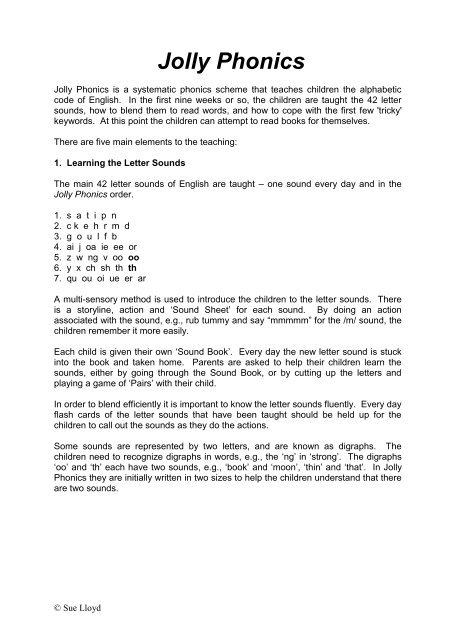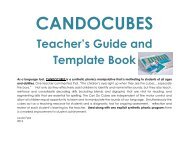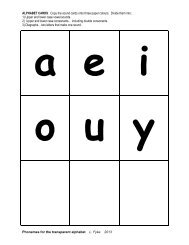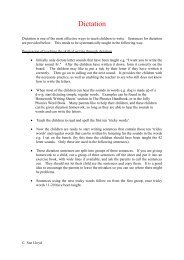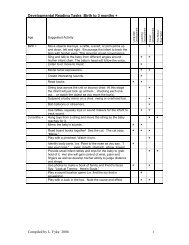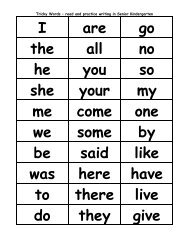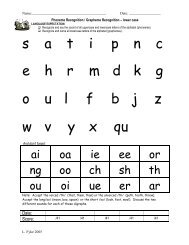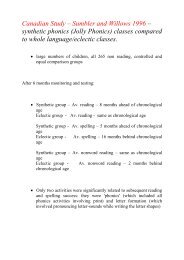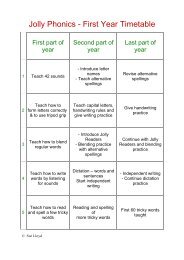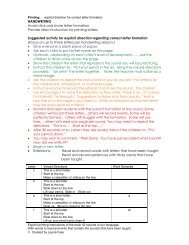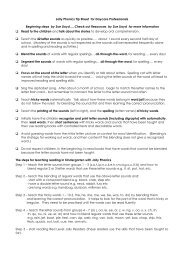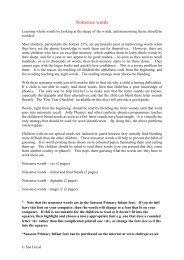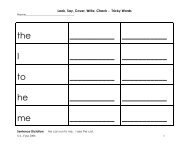A - Jolly Phonics.pdf - Primarily Learning
A - Jolly Phonics.pdf - Primarily Learning
A - Jolly Phonics.pdf - Primarily Learning
You also want an ePaper? Increase the reach of your titles
YUMPU automatically turns print PDFs into web optimized ePapers that Google loves.
<strong>Jolly</strong> <strong>Phonics</strong><br />
<strong>Jolly</strong> <strong>Phonics</strong> is a systematic phonics scheme that teaches children the alphabetic<br />
code of English. In the first nine weeks or so, the children are taught the 42 letter<br />
sounds, how to blend them to read words, and how to cope with the first few 'tricky'<br />
keywords. At this point the children can attempt to read books for themselves.<br />
There are five main elements to the teaching:<br />
1. <strong>Learning</strong> the Letter Sounds<br />
The main 42 letter sounds of English are taught – one sound every day and in the<br />
<strong>Jolly</strong> <strong>Phonics</strong> order.<br />
1. s a t i p n<br />
2. c k e h r m d<br />
3. g o u l f b<br />
4. ai j oa ie ee or<br />
5. z w ng v oo oo<br />
6. y x ch sh th th<br />
7. qu ou oi ue er ar<br />
A multi-sensory method is used to introduce the children to the letter sounds. There<br />
is a storyline, action and „Sound Sheet‟ for each sound. By doing an action<br />
associated with the sound, e.g., rub tummy and say “mmmmm” for the /m/ sound, the<br />
children remember it more easily.<br />
Each child is given their own „Sound Book‟. Every day the new letter sound is stuck<br />
into the book and taken home. Parents are asked to help their children learn the<br />
sounds, either by going through the Sound Book, or by cutting up the letters and<br />
playing a game of „Pairs‟ with their child.<br />
In order to blend efficiently it is important to know the letter sounds fluently. Every day<br />
flash cards of the letter sounds that have been taught should be held up for the<br />
children to call out the sounds as they do the actions.<br />
Some sounds are represented by two letters, and are known as digraphs. The<br />
children need to recognize digraphs in words, e.g., the „ng‟ in „strong‟. The digraphs<br />
„oo‟ and „th‟ each have two sounds, e.g., „book‟ and „moon‟, „thin‟ and „that‟. In <strong>Jolly</strong><br />
<strong>Phonics</strong> they are initially written in two sizes to help the children understand that there<br />
are two sounds.<br />
© Sue Lloyd
2. <strong>Learning</strong> Letter Formation<br />
As the letter sounds are introduced, the children are shown exactly how to form each<br />
letter correctly. Initially, the children form the letters in the air, at the same time as the<br />
teacher. By regularly feeling the formation of each letter, and then writing it, most<br />
children will form their letters correctly after the first twelve weeks or so. It is also<br />
important to teach the children to hold their pencil correctly, in the tripod grip. Feeling<br />
letter formation in the Finger <strong>Phonics</strong> books or tracing over dotted letters also gives<br />
good practice.<br />
The <strong>Jolly</strong> <strong>Phonics</strong> material uses Sassoon typefaces. One typeface has joining tails,<br />
while another has print letters.<br />
3. Blending<br />
As well as learning the sounds the letters make, the children need to be taught how to<br />
blend them together to hear a word. This teaching starts on the first day. The aim is<br />
to enable the children to hear the word when the teacher says the sounds, e.g.,<br />
“Listen carefully, what word am I saying … „d-o-g‟?” A few children will hear „dog‟.<br />
Try a few more words, such as „s-u-n‟, „b-oy‟, „m-ou-s‟.<br />
Once the children can hear the word when an adult says the sounds, they are ready<br />
to try and blend words for themselves. Initially, being able to blend letter sounds<br />
fluently is the essential skill for reading and should always be the first strategy for<br />
working out unknown words. Children must also be able to recognize consonant<br />
blends and digraphs in words such as „fl-a-g‟ and „sh-o-p‟.<br />
After most of the 42 letter sounds have been taught and the children can read simple,<br />
regular words they begin taking home the „Word Boxes‟ for extra practice. The Word<br />
Boxes start with simple words made from the first group of letter sounds. The children<br />
who are the fastest at learning to blend letter sounds tend to become the more fluent<br />
readers.<br />
As soon as the children have worked their way through the Word Boxes, and learned<br />
the first ten tricky words, they are ready to start on the Red Level <strong>Jolly</strong> Readers. The<br />
words in these readers are controlled so that the children can successfully work them<br />
out. Once there is confidence and fluency in the reading then the children are able to<br />
read a wide variety of books that do not have controlled vocabulary. It is helpful to<br />
encourage parents to talk about and enjoy the stories with their children. The Read<br />
and See books are useful for the children who need more practice with blending<br />
words.<br />
At first, one way of spelling each vowel sound is taught, e.g., „ai‟ as in „rain‟. The<br />
children should have practice blending these spellings in words before the alternatives<br />
are introduced, e.g., „ay‟ as in „play‟ and „a-e‟ as in „lane‟.<br />
© Sue Lloyd
4. Identifying Sounds In Words<br />
It is essential that children are taught to hear the individual sounds in words,<br />
especially for helping them to spell words. Initially, the children are asked to listen<br />
carefully and say if they can hear a given sound in words. Start with words that have<br />
three sounds in them, for example, “Is there a „s‟ in „sun‟ … „mouse‟ … „dog‟?”; “If<br />
there is a „s‟ where does it come – the beginning, middle or end?”. Then the children<br />
are encouraged to say the sounds they hear. Practice by saying a word like „hat‟.<br />
The children should respond by saying „h-a-t‟. As they say each sound they hold up a<br />
finger … „h-a-t‟ three fingers, three sounds; „sh-i-p‟ three fingers, three sounds, etc.<br />
After this progress to more complicated words, such as those with initial and final<br />
consonant blends.<br />
The teacher can sometimes write the letters on the board as the children say the letter<br />
sounds. Then the children look at the word, say the sounds and blend them to read<br />
the word. This gives a good understanding of how reading and writing work. A few<br />
examples every day helps to develop this skill.<br />
As soon as the children can hear the sounds in three letter words they can start their<br />
dictation homework, material in The <strong>Phonics</strong> Handbook.<br />
When children can hear the sounds in words, and know one way of writing each<br />
sound, they can write independently. Initially, the children will not spell accurately but<br />
their work can be read, for example, „I went hors riedin that wos fun‟. Most children,<br />
by the end of their first year, should be able to write their own news and simple stories<br />
independently. It will be exactly what they want to say, as they are not restricted to<br />
writing only the words they have learned by heart. Accurate spelling develops<br />
gradually from reading books, knowing the alternative vowel sounds and following a<br />
spelling scheme.<br />
5. Tricky Words<br />
After their first six weeks at school, when the majority of the children know about 35<br />
letter sounds and have been blending regular words as a group activity, they can<br />
begin to learn the tricky words. Tricky words are words that cannot always be worked<br />
out by blending. These can be introduced gradually using the <strong>Jolly</strong> <strong>Phonics</strong> Tricky<br />
Word Cards or Tricky Word Wall Flowers. Look at what is „tricky‟ in each word, e.g.,<br />
„was‟ has an /o/ sound in the middle instead of an /a/ sound. Try and teach at least 2–<br />
3 a week, continually revising for reading and spelling.<br />
Three spelling techniques are:<br />
• Look (identify the irregularity and say the letter names), Cover, Write and<br />
Check.<br />
• Say It As It Sounds, e.g., pronounce „mother‟ with a short /o/ sound so that<br />
it rhymes with „bother‟.<br />
• Mnemonics, e.g., „people eat omelettes people like eggs‟ to spell the word<br />
„people‟.<br />
© Sue Lloyd
6. Conclusion: Aims to Achieve in the First Nine Weeks<br />
All the children to:<br />
• read and write the 42 letter sounds,<br />
• form the letters correctly, holding their pencil in the tripod grip,<br />
• blend regular words fluently, for example, „leg‟, „flag‟, „shoot‟, „bringing‟ etc.,<br />
• write simple, regular words by listening for the sounds, for example, „b-e-d‟,<br />
„f-l-a-t‟, „s-p-oo-n‟ etc., and<br />
• read the first 10 tricky words.<br />
7. What Comes After the First 9 Weeks?<br />
Every day a little work on each skill is needed:<br />
1. Frequently work through the flash cards of the letter sounds:<br />
– including the alternative spellings, e.g., „er‟, „ir‟, „ur‟,<br />
– practice reading regular words that use the alternative spellings.<br />
2. Develop the ability to write fluently and neatly:<br />
– correct formation of capital as well as lower-case letters,<br />
– dictation of words and sentences.<br />
3. Develop reading fluency and comprehension:<br />
– reading individually to parents or to adults in school,<br />
– group and silent reading,<br />
– develop a wider vocabulary and understanding of the meaning of words.<br />
4. Develop writing skills:<br />
– draw pictures on the board and ask the children to write a sentence<br />
about each one,<br />
– write news independently,<br />
– write simple stories that have been told to them by the teacher,<br />
– write the first sentence of a story on the board for the children to copy<br />
and continue,<br />
– create and writing their own simple stories,<br />
– write up science and topic work.<br />
5. Continue teaching the tricky words for reading and spelling.<br />
© Sue Lloyd


